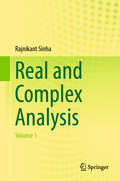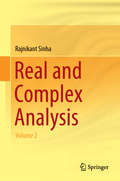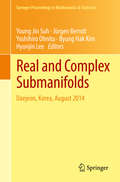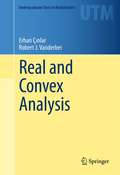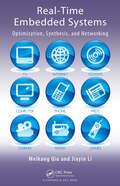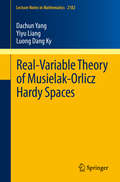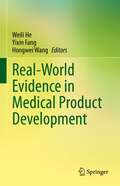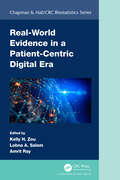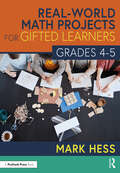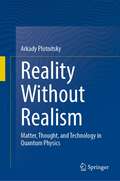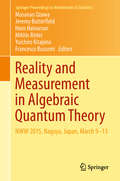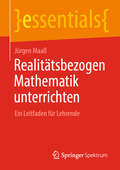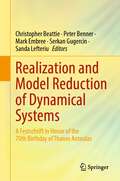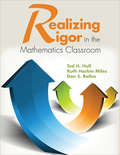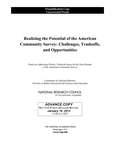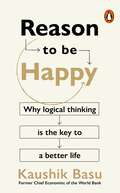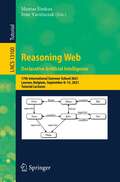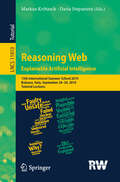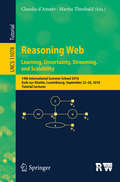- Table View
- List View
Real and Complex Analysis: Volume 2
by Rajnikant SinhaThis is the first volume of the two-volume book on real and complex analysis. This volume is an introduction to measure theory and Lebesgue measure where the Riesz representation theorem is used to construct Lebesgue measure. Intended for undergraduate students of mathematics and engineering, it covers the essential analysis that is needed for the study of functional analysis, developing the concepts rigorously with sufficient detail and with minimum prior knowledge of the fundamentals of advanced calculus required. Divided into three chapters, it discusses exponential and measurable functions, Riesz representation theorem, Borel and Lebesgue measure, -spaces, Riesz–Fischer theorem, Vitali–Caratheodory theorem, the Fubini theorem, and Fourier transforms. Further, it includes extensive exercises and their solutions with each concept. The book examines several useful theorems in the realm of real and complex analysis, most of which are the work of great mathematicians of the 19th and 20th centuries.
Real and Complex Analysis: Volume 2
by Rajnikant SinhaThis is the second volume of the two-volume book on real and complex analysis. This volume is an introduction to the theory of holomorphic functions. Multivalued functions and branches have been dealt carefully with the application of the machinery of complex measures and power series. Intended for undergraduate students of mathematics and engineering, it covers the essential analysis that is needed for the study of functional analysis, developing the concepts rigorously with sufficient detail and with minimum prior knowledge of the fundamentals of advanced calculus required. Divided into four chapters, it discusses holomorphic functions and harmonic functions, Schwarz reflection principle, infinite product and the Riemann mapping theorem, analytic continuation, monodromy theorem, prime number theorem, and Picard’s little theorem. Further, it includes extensive exercises and their solutions with each concept. The book examines several useful theorems in the realm of real and complex analysis, most of which are the work of great mathematicians of the 19th and 20th centuries.
Real and Complex Submanifolds
by Young Jin Suh Jürgen Berndt Yoshihiro Ohnita Byung Hak Kim Hyunjin LeeEdited in collaboration with the Grassmann Research Group, this book contains many important articles delivered at the ICM 2014 Satellite Conference and the 18th International Workshop on Real and Complex Submanifolds, which was held at the National Institute for Mathematical Sciences, Daejeon, Republic of Korea, August 10-12, 2014. The book covers various aspects of differential geometry focused on submanifolds, symmetric spaces, Riemannian and Lorentzian manifolds, and Kähler and Grassmann manifolds.
Real and Convex Analysis
by Robert J Vanderbei Erhan ÇınlarThis book offers a first course in analysis for scientists and engineers. It can be used at the advanced undergraduate level or as part of the curriculum in a graduate program. The book is built around metric spaces. In the first three chapters, the authors lay the foundational material and cover the all-important "four-C's": convergence, completeness, compactness, and continuity. In subsequent chapters, the basic tools of analysis are used to give brief introductions to differential and integral equations, convex analysis, and measure theory. The treatment is modern and aesthetically pleasing. It lays the groundwork for the needs of classical fields as well as the important new fields of optimization and probability theory.
Real-Time Embedded Systems: Optimization, Synthesis, and Networking
by Meikang Qiu Jiayin LiUbiquitous in today's consumer-driven society, embedded systems use microprocessors that are hidden in our everyday products and designed to perform specific tasks. Effective use of these embedded systems requires engineers to be proficient in all phases of this effort, from planning, design, and analysis to manufacturing and marketing.Taking a sys
Real-Time Progressive Hyperspectral Image Processing
by Chein-I ChangThe book covers the most crucial parts of real-time hyperspectral image processing: causality and real-time capability. Recently, two new concepts of real time hyperspectral image processing, Progressive HyperSpectral Imaging (PHSI) and Recursive HyperSpectral Imaging (RHSI). Both of these can be used to design algorithms and also form an integral part of real time hyperpsectral image processing. This book focuses on progressive nature in algorithms on their real-time and causal processing implementation in two major applications, endmember finding and anomaly detection, both of which are fundamental tasks in hyperspectral imaging but generally not encountered in multispectral imaging. This book is written to particularly address PHSI in real time processing, while a book, Recursive Hyperspectral Sample and Band Processing: Algorithm Architecture and Implementation (Springer 2016) can be considered as its companion book.
Real-Variable Theory of Hardy Spaces Associated with Generalized Herz Spaces of Rafeiro and Samko (Lecture Notes in Mathematics #2320)
by Dachun Yang Yinqin Li Long HuangThe real-variable theory of function spaces has always been at the core of harmonic analysis. In particular, the real-variable theory of the Hardy space is a fundamental tool of harmonic analysis, with applications and connections to complex analysis, partial differential equations, and functional analysis.This book is devoted to exploring properties of generalized Herz spaces and establishing a complete real-variable theory of Hardy spaces associated with local and global generalized Herz spaces via a totally fresh perspective. This means that the authors view these generalized Herz spaces as special cases of ball quasi-Banach function spaces.In this book, the authors first give some basic properties of generalized Herz spaces and obtain the boundedness and the compactness characterizations of commutators on them. Then the authors introduce the associated Herz–Hardy spaces, localized Herz–Hardy spaces, and weak Herz–Hardy spaces, and develop a complete real-variable theory of these Herz–Hardy spaces, including their various maximal function, atomic, molecular as well as various Littlewood–Paley function characterizations. As applications, the authors establish the boundedness of some important operators arising from harmonic analysis on these Herz–Hardy spaces. Finally, the inhomogeneous Herz–Hardy spaces and their complete real-variable theory are also investigated.With the fresh perspective and the improved conclusions on the real-variable theory of Hardy spaces associated with ball quasi-Banach function spaces, all the obtained results of this book are new and their related exponents are sharp. This book will be appealing to researchers and graduate students who are interested in function spaces and their applications.
Real-Variable Theory of Musielak-Orlicz Hardy Spaces
by Dachun Yang Yiyu Liang Luong Dang KyThe main purpose of this book is to give a detailed and complete survey of recent progress related to the real-variable theory of Musielak-Orlicz Hardy-type function spaces, and to lay the foundations for further applications. The real-variable theory of function spaces has always been at the core of harmonic analysis. Recently, motivated by certain questions in analysis, some more general Musielak-Orlicz Hardy-type function spaces were introduced. These spaces are defined via growth functions which may vary in both the spatial variable and the growth variable. By selecting special growth functions, the resulting spaces may have subtler and finer structures, which are necessary in order to solve various endpoint or sharp problems. This book is written for graduate students and researchers interested in function spaces and, in particular, Hardy-type spaces.
Real-World Evidence in Drug Development and Evaluation (Chapman & Hall/CRC Biostatistics Series)
by Harry Yang Binbing YuReal-world evidence (RWE) has been at the forefront of pharmaceutical innovations. It plays an important role in transforming drug development from a process aimed at meeting regulatory expectations to an operating model that leverages data from disparate sources to aid business, regulatory, and healthcare decision making. Despite its many benefits, there is no single book systematically covering the latest development in the field.Written specifically for pharmaceutical practitioners, Real-World Evidence in Drug Development and Evaluation, presents a wide range of RWE applications throughout the lifecycle of drug product development. With contributions from experienced researchers in the pharmaceutical industry, the book discusses at length RWE opportunities, challenges, and solutions. Features Provides the first book and a single source of information on RWE in drug development Covers a broad array of topics on outcomes- and value-based RWE assessments Demonstrates proper Bayesian application and causal inference for real-world data (RWD) Presents real-world use cases to illustrate the use of advanced analytics and statistical methods to generate insights Offers a balanced discussion of practical RWE issues at hand and technical solutions suitable for practitioners with limited data science expertise
Real-World Evidence in Medical Product Development
by Weili He Hongwei Wang Yixin FangThis book provides state-of-art statistical methodologies, practical considerations from regulators and sponsors, logistics, and real use cases for practitioners for the uptake of RWE/D. Randomized clinical trials have been the gold standard for the evaluation of efficacy and safety of medical products. However, the cost, duration, practicality, and limited generalizability have incentivized many to look for alternative ways to optimize drug development. This book provides a comprehensive list of topics together to include all aspects with the uptake of RWE/D, including, but not limited to, applications in regulatory and non-regulatory settings, causal inference methodologies, organization and infrastructure considerations, logistic challenges, and practical use cases.
Real-World Evidence in a Patient-Centric Digital Era (Chapman & Hall/CRC Biostatistics Series)
by Amrit Ray Kelly H Zou Lobna A. SalemReal-world evidence is defined as evidence generated from real-world data outside randomized controlled trials. As scientific discoveries and methodologies continue to advance, real-world data and their companion technologies offer powerful new tools for evidence generation. Real-World Evidence in a Patient-Centric Digital Era provides perspectives, examples, and insights on the innovative application of real-world evidence to meet patient needs and improve healthcare, with a focus on the pharmaceutical industry. This book presents an overview of key analytical issues and best practices. Special attention is paid to the development, methodologies, and other salient features of the statistical and data science techniques that are customarily used to generate real-world evidence. It provides a review of key topics and emerging trends in cutting-edge data science and health innovation. Features: Provides an overview of statistical and analytic methodologies in real-world evidence to generate insights on healthcare, with a special focus on the pharmaceutical industry Examines timely topics of high relevance to industry such as bioethical considerations, regulatory standards, and compliance requirements Highlights emerging and current trends, and provides guidelines for best practices Illustrates methods through examples and use-case studies to demonstrate impact Provides guidance on software choices and digital applications for successful analytics Real-World Evidence in a Patient-Centric Digital Era will be a vital reference for medical researchers, health technology innovators, data scientists, epidemiologists, population health analysts, health economists, outcomes researchers, policymakers, and analysts in the healthcare industry.
Real-World Math Projects for Gifted Learners, Grades 4-5
by Mark HessHelping bring mathematics and engineering to life, these challenging lessons give teachers an exciting tool for engaging advanced learners through creativity and hands-on products. Units are driven by standards and invite students to become baseball field architects, create flying jellyfish, make a gnome hat parachute, scale skyscrapers, and more! Each project includes step-by-step lesson plans with reproducible templates, time estimates, and a materials list. While centered on STEAM (science, technology, engineering, arts, and mathematics) competencies, true to real-world experiences, these hands-on projects span the curriculum—including writing and public speaking—and while they suit entire classrooms and smaller groups, they can also be easily adapted to individual projects for independent study and home school.
Reality Without Realism: Matter, Thought, and Technology in Quantum Physics
by Arkady PlotnitskyThis book presents quantum theory as a theory based on new relationships among matter, thought, and experimental technology, as against those previously found in physics, relationships that also redefine those between mathematics and physics in quantum theory. The argument of the book is based on its title concept, reality without realism (RWR), and in the corresponding view, the RWR view, of quantum theory. The book considers, from this perspective, the thinking of Bohr, Heisenberg, Schrödinger, and Dirac, with the aim of bringing together the philosophy and history of quantum theory. With quantum theory, the book argues, the architecture of thought in theoretical physics was radically changed by the irreducible role of experimental technology in the constitution of physical phenomena, accordingly, no longer defined independently by matter alone, as they were in classical physics or relativity. Or so it appeared. For, quantum theory, the book further argues, made us realize that experimental technology, beginning with that of our bodies, irreducibly shapes all physical phenomena, and thus makes us rethink the relationships among matter, thought, and technology in all of physics.
Reality and Measurement in Algebraic Quantum Theory: Nagoya, Japan, March 9-13 2015 (Springer Proceedings in Mathematics & Statistics #261)
by Miklós Rédei Francesco Buscemi Jeremy Butterfield Masanao Ozawa Hans Halvorson Yuichiro KitajimaThis volume contains papers based on presentations at the “Nagoya Winter Workshop 2015: Reality and Measurement in Algebraic Quantum Theory (NWW 2015)”, held in Nagoya, Japan, in March 2015. The foundations of quantum theory have been a source of mysteries, puzzles, and confusions, and have encouraged innovations in mathematical languages to describe, analyze, and delineate this wonderland. Both ontological and epistemological questions about quantum reality and measurement have been placed in the center of the mysteries explored originally by Bohr, Heisenberg, Einstein, and Schrödinger. This volume describes how those traditional problems are nowadays explored from the most advanced perspectives. It includes new research results in quantum information theory, quantum measurement theory, information thermodynamics, operator algebraic and category theoretical foundations of quantum theory, and the interplay between experimental and theoretical investigations on the uncertainty principle. This book is suitable for a broad audience of mathematicians, theoretical and experimental physicists, and philosophers of science.
Realitätsbezogen Mathematik unterrichten: Ein Leitfaden für Lehrende (essentials)
by Jürgen MaaßIn diesem Essential wird an Beispielen erläutert, wie und mit welchen Herausforderungen gute realitätsbezogene Aufgaben und Unterrichtseinheiten gefunden und genutzt werden können. Dabei werden die Leserinnen und Leser immer wieder eingeladen, selbst etwas auszuprobieren.
Realization and Model Reduction of Dynamical Systems: A Festschrift in Honor of the 70th Birthday of Thanos Antoulas
by Peter Benner Mark Embree Christopher Beattie Serkan Gugercin Sanda LefteriuThis book celebrates Professor Thanos Antoulas's 70th birthday, marking his fundamental contributions to systems and control theory, especially model reduction and, more recently, data-driven modeling and system identification. Model reduction is a prominent research topic with wide ranging scientific and engineering applications.
Realizing Rigor in the Mathematics Classroom
by Don S. Balka Ted H. Hull Ruth Harbin MilesRigor put within reach! Rigor: The Common Core has made it policy—and this first-of-its-kind guide takes math teachers and leaders through the process of making it reality. Using the Proficiency Matrix as a framework, the authors offer proven strategies and practical tools for successful implementation of the CCSS mathematical practices—with rigor as a central objective. You’ll learn how to Define rigor in the context of each mathematical practice Identify and overcome potential issues, including differentiating instruction and using data Relate specific roles and goals for all stakeholders Use assessment tools to guide work and monitor progress
Realizing the Potential of the American Community Survey: Challenges, Tradeoffs, and Opportunities
by Panel on Addressing Priority Technical Issues for the Next Decade of the American Community SurveyThe American Community Survey (ACS) was conceptualized as a replacement to the census long form, which collected detailed population and housing data from a sample of the U. S. population, once a decade, as part of the decennial census operations. The long form was traditionally the main source of socio-economic information for areas below the national level. The data provided for small areas, such as counties, municipalities, and neighborhoods is what made the long form unique, and what makes the ACS unique today. Since the successful transition from the decennial long form in 2005, the ACS has become an invaluable resource for many stakeholders, particularly for meeting national and state level data needs. However, due to inadequate sample sizes, a major challenge for the survey is producing reliable estimates for smaller geographic areas, which is a concern because of the unique role fulfilled by the long form, and now the ACS, of providing data with a geographic granularity that no other federal survey could provide. In addition to the primary challenge associated with the reliability of the estimates, this is also a good time to assess other aspects of the survey in order to identify opportunities for refinement based on the experience of the first few years. "Realizing the Potential of the American Community Survey" provides input on ways of improving the ACS, focusing on two priority areas: identifying methods that could improve the quality of the data available for small areas, and suggesting changes that would increase the survey's efficiency in responding to new data needs. This report considers changes that the ACS office should consider over the course of the next few years in order to further improve the ACS data. The recommendations of "Realizing the Potential of the American Community Survey" will help the Census Bureau improve performance in several areas, which may ultimately lead to improved data products as the survey enters its next decade.
Reason to Be Happy: Why logical thinking is the key to a better life
by Kaushik Basu'Reason to Be Happy is a wise and witty book that shows how thinking clearly can help us find happiness in our daily lives, get more of what we want, and even make the world a better place' Hannah FryWhy do our friends have more friends than we do? How do you book the best available seats on a plane? And if jogging for ten minutes adds eight minutes to our life expectancy, should we still go jogging?The ability to reason is one of our most undervalued skills. In everyday life, the key is to put yourself in the shoes of a clever competitor and think about how they might respond. Whether you are dealing with events on the scale of the Cuban missile crisis or letting go of anger, leading economist Professor Kaushik Basu shows how game theory - the logic of social situations - can help us achieve better outcomes and lasting happiness.Full of fascinating thought experiments and puzzles, Reason to Be Happy is a paean to the power of rationality. If you want to have a good life and even make the world a better place, you can start by thinking clearly.
Reasoning Web. Declarative Artificial Intelligence: 17th International Summer School 2021, Leuven, Belgium, September 8–15, 2021, Tutorial Lectures (Lecture Notes in Computer Science #13100)
by Mantas Šimkus Ivan VarzinczakThe purpose of the Reasoning Web Summer School is to disseminate recent advances on reasoning techniques and related issues that are of particular interest to Semantic Web and Linked Data applications. It is primarily intended for postgraduate students, postdocs, young researchers, and senior researchers wishing to deepen their knowledge. As in the previous years, lectures in the summer school were given by a distinguished group of expert lecturers.The broad theme of this year's summer school was again “Declarative Artificial Intelligence” and it covered various aspects of ontological reasoning and related issues that are of particular interest to Semantic Web and Linked Data applications. The following eight lectures were presented during the school: Foundations of Graph Path Query Languages; On Combining Ontologies and Rules; Modelling Symbolic Knowledge Using Neural Representations; Mining the Semantic Web with Machine Learning: Main Issues That Need to Be Known; Temporal ASP: From Logical Foundations to Practical Use with telingo; A Review of SHACL: From Data Validation to Schema Reasoning for RDF Graphs; and Score-Based Explanations in Data Management and Machine Learning.
Reasoning Web. Explainable Artificial Intelligence: 15th International Summer School 2019, Bolzano, Italy, September 20–24, 2019, Tutorial Lectures (Lecture Notes in Computer Science #11810)
by Markus Krötzsch Daria StepanovaThis volume contains lecture notes of the 15th Reasoning Web Summer School (RW 2019), held in Bolzano, Italy, in September 2019. The research areas of Semantic Web, Linked Data, and Knowledge Graphs have recently received a lot of attention in academia and industry. Since its inception in 2001, the Semantic Web has aimed at enriching the existing Web with meta-data and processing methods, so as to provide Web-based systems with intelligent capabilities such as context awareness and decision support. The Semantic Web vision has been driving many community efforts which have invested a lot of resources in developing vocabularies and ontologies for annotating their resources semantically. Besides ontologies, rules have long been a central part of the Semantic Web framework and are available as one of its fundamental representation tools, with logic serving as a unifying foundation. Linked Data is a related research area which studies how one can make RDF data available on the Web and interconnect it with other data with the aim of increasing its value for everybody. Knowledge Graphs have been shown useful not only for Web search (as demonstrated by Google, Bing, etc.) but also in many application domains.
Reasoning Web. Learning, Uncertainty, Streaming, and Scalability: 14th International Summer School 2018, Esch-sur-Alzette, Luxembourg, September 22–26, 2018, Tutorial Lectures (Lecture Notes in Computer Science #11078)
by Claudia D’Amato Martin TheobaldThis volume contains lecture notes of the 14th Reasoning Web Summer School (RW 2018), held in Esch-sur-Alzette, Luxembourg, in September 2018. The research areas of Semantic Web, Linked Data, and Knowledge Graphs have recently received a lot of attention in academia and industry. Since its inception in 2001, the Semantic Web has aimed at enriching the existing Web with meta-data and processing methods, so as to provide Web-based systems with intelligent capabilities such as context awareness and decision support. The Semantic Web vision has been driving many community efforts which have invested a lot of resources in developing vocabularies and ontologies for annotating their resources semantically. Besides ontologies, rules have long been a central part of the Semantic Web framework and are available as one of its fundamental representation tools, with logic serving as a unifying foundation. Linked Data is a related research area which studies how one can make RDF data available on the Web and interconnect it with other data with the aim of increasing its value for everybody. Knowledge Graphs have been shown useful not only for Web search (as demonstrated by Google, Bing, etc.) but also in many application domains.
Reasoning Web: 12th International Summer School 2016, Aberdeen, UK, September 5-9, 2016, Tutorial Lectures (Lecture Notes in Computer Science #9885)
by Jeff Z. Pan, Diego Calvanese, Thomas Eiter, Ian Horrocks, Michael Kifer, Fangzhen Lin and Yuting ZhaoThis volume contains some lecture notes of the 12th Reasoning Web Summer School (RW 2016), held in Aberdeen, UK, in September 2016.In 2016, the theme of the school was “Logical Foundation of Knowledge Graph Construction and Query Answering”. The notion of knowledge graph has become popular since Google started to use it to improve its search engine in 2012. Inspired by the success of Google, knowledge graphs are gaining momentum in the World Wide Web arena. Recent years have witnessed increasing industrial take-ups by other Internet giants, including Facebook's Open Graph and Microsoft's Satori. The aim of the lecture note is to provide a logical foundation for constructing and querying knowledge graphs. Our journey starts from the introduction of Knowledge Graph as well as its history, and the construction of knowledge graphs by considering both explicit and implicit author intentions. The book will then cover various topics, including how to revise and reuse ontologies (schema of knowledge graphs) in a safe way, how to combine navigational queries with basic pattern matching queries for knowledge graph, how to setup a environment to do experiments on knowledge graphs, how to deal with inconsistencies and fuzziness in ontologies and knowledge graphs, and how to combine machine learning and machine reasoning for knowledge graphs.
Reasons to Reason in Primary Maths and Science
by Alan Cross Alison BorthwickHow can teachers help children to develop reasoning skills? What is reasoning and how do we teach it? Much is being said in schools and education about the importance of reasoning skills. This book explores what reasoning is and what it is not. It includes examples of how reasoning in primary mathematics and science classes can develop. It shows how a connection between the 'skills' of mathematics and science can help children to gain a better understanding of reasoning. What is a conjecture? What makes you think? What makes you think about your thinking? What does reasoning look like? With links to classroom practice and examples of effective teaching throughout, this book not only provides an exploration of what reasoning is and why it's important - it also show you how to develop children's reasoning skills in your classroom.
Reasons to Reason in Primary Maths and Science
by Alan Cross Alison BorthwickHow can teachers help children to develop reasoning skills?What is reasoning and how do we teach it?Much is being said in schools and education about the importance of reasoning skills. This book explores what reasoning is and what it is not. It includes examples of how reasoning in primary mathematics and science classes can develop. It shows how a connection between the ′skills′ of mathematics and science can help children to gain a better understanding of reasoning. What is a conjecture What makes you think? What makes you think about your thinking? What does reasoning look like? With links to classroom practice and examples of effective teaching throughout, this book not only provides an exploration of what reasoning is and why it′s important—it also show you how to develop children′s reasoning skills in your classroom.
